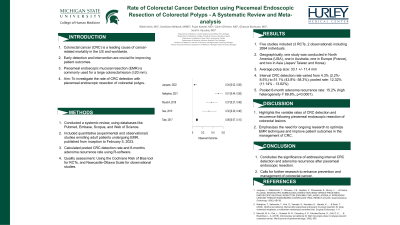Monday Poster Session
Category: Interventional Endoscopy
P2288 - Rate of Colorectal Cancer Detection Using Piecemeal Endoscopic Resection of Colorectal Polyps - A Systematic Review and Meta-analysis
Monday, October 23, 2023
10:30 AM - 4:15 PM PT
Location: Exhibit Hall

Has Audio

Bibek Karki, MD
Hurley Medical Center
Flint, MI
Presenting Author(s)
Bibek Karki, MD1, Samjhana Belbase, MBBS2, Pujan Kandel, MD3, Calvin Ghimire, MD4, Ghassan Bachuwa, MD5, Sunil Kaushal, FACG5
1Hurley Medical Center, Flint, MI; 2College of Medical Sciences, Kathmandu, Bagmati, Nepal; 3Mayo Clinic, Jacksonville, FL; 4Michigan State University/McLaren Flint Hospital, Flint, MI; 5Michigan State University, Flint, MI
Introduction: Colorectal cancer (CRC) is a leading cause of cancer-related mortality in the US and worldwide, highlighting the importance of early detection and intervention for improving patient outcomes. Endoscopic mucosal resection (EMR) is a well-established technique for the treatment of large colorectal polyps of ≥ 20 mm in size. However, the main drawback of this technique is adenoma recurrence. To our knowledge, there is no review conducted to evaluate the interval cancer development after EMR. The aim of our study is to investigate the rate interval of CRC detection after EMR of large colorectal polyps.
Methods: We conducted a systematic review using databases like Pubmed, Embase, Scopus, and Web of Science. We included quantitative (experimental and observational) studies that enrolled adult patients undergoing EMR of colorectal polyps, published from inception to February 5, 2023.
The primary outcome assessed was the pooled interval colorectal cancer detection rate, while the secondary outcome evaluated was the adenoma recurrence rate at 6 months following endoscopic piecemeal resection. The quality of the included studies was assessed using the Cochrane Risk of Bias tool for randomized controlled trials, and the Newcastle-Ottawa Scale for observational studies.
Results: Our analysis included a total of five studies were included, consisting of three randomized controlled trials (RCTs) and two observational studies, with a total of 2694 individuals. The average polyp size across the study is 33.1 +/- 11.4 mm. The interval CRC detection rate including high-grade dysplasia and cancer ranged from 4.3 % (2.2 % - 8.5%) to 51.1 % (43.8 % - 58.3 %) with a pooled detection rate of 12.32 % (11.14 % - 13.62 %). The 6-month adenoma recurrence rate ranged from 5.1 % (2.6 % - 9.2 %) to 33.30 % (13.1 %-62.4 %), with a pooled rate for CRC recurrence is 15.2 %.
Discussion: This study highlights the interval CRC detection and adenoma recurrence following piecemeal endoscopic resection of colorectal lesions. Our findings emphasize the importance of research to explore, refine and optimize endoscopic mucosal resection techniques to improve the prevention and management of colorectal cancer.
Disclosures:
Bibek Karki, MD1, Samjhana Belbase, MBBS2, Pujan Kandel, MD3, Calvin Ghimire, MD4, Ghassan Bachuwa, MD5, Sunil Kaushal, FACG5. P2288 - Rate of Colorectal Cancer Detection Using Piecemeal Endoscopic Resection of Colorectal Polyps - A Systematic Review and Meta-analysis, ACG 2023 Annual Scientific Meeting Abstracts. Vancouver, BC, Canada: American College of Gastroenterology.
1Hurley Medical Center, Flint, MI; 2College of Medical Sciences, Kathmandu, Bagmati, Nepal; 3Mayo Clinic, Jacksonville, FL; 4Michigan State University/McLaren Flint Hospital, Flint, MI; 5Michigan State University, Flint, MI
Introduction: Colorectal cancer (CRC) is a leading cause of cancer-related mortality in the US and worldwide, highlighting the importance of early detection and intervention for improving patient outcomes. Endoscopic mucosal resection (EMR) is a well-established technique for the treatment of large colorectal polyps of ≥ 20 mm in size. However, the main drawback of this technique is adenoma recurrence. To our knowledge, there is no review conducted to evaluate the interval cancer development after EMR. The aim of our study is to investigate the rate interval of CRC detection after EMR of large colorectal polyps.
Methods: We conducted a systematic review using databases like Pubmed, Embase, Scopus, and Web of Science. We included quantitative (experimental and observational) studies that enrolled adult patients undergoing EMR of colorectal polyps, published from inception to February 5, 2023.
The primary outcome assessed was the pooled interval colorectal cancer detection rate, while the secondary outcome evaluated was the adenoma recurrence rate at 6 months following endoscopic piecemeal resection. The quality of the included studies was assessed using the Cochrane Risk of Bias tool for randomized controlled trials, and the Newcastle-Ottawa Scale for observational studies.
Results: Our analysis included a total of five studies were included, consisting of three randomized controlled trials (RCTs) and two observational studies, with a total of 2694 individuals. The average polyp size across the study is 33.1 +/- 11.4 mm. The interval CRC detection rate including high-grade dysplasia and cancer ranged from 4.3 % (2.2 % - 8.5%) to 51.1 % (43.8 % - 58.3 %) with a pooled detection rate of 12.32 % (11.14 % - 13.62 %). The 6-month adenoma recurrence rate ranged from 5.1 % (2.6 % - 9.2 %) to 33.30 % (13.1 %-62.4 %), with a pooled rate for CRC recurrence is 15.2 %.
Discussion: This study highlights the interval CRC detection and adenoma recurrence following piecemeal endoscopic resection of colorectal lesions. Our findings emphasize the importance of research to explore, refine and optimize endoscopic mucosal resection techniques to improve the prevention and management of colorectal cancer.
Disclosures:
Bibek Karki indicated no relevant financial relationships.
Samjhana Belbase indicated no relevant financial relationships.
Pujan Kandel indicated no relevant financial relationships.
Calvin Ghimire indicated no relevant financial relationships.
Ghassan Bachuwa indicated no relevant financial relationships.
Sunil Kaushal indicated no relevant financial relationships.
Bibek Karki, MD1, Samjhana Belbase, MBBS2, Pujan Kandel, MD3, Calvin Ghimire, MD4, Ghassan Bachuwa, MD5, Sunil Kaushal, FACG5. P2288 - Rate of Colorectal Cancer Detection Using Piecemeal Endoscopic Resection of Colorectal Polyps - A Systematic Review and Meta-analysis, ACG 2023 Annual Scientific Meeting Abstracts. Vancouver, BC, Canada: American College of Gastroenterology.
